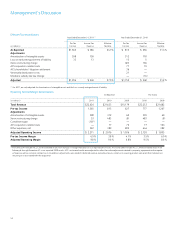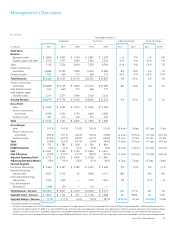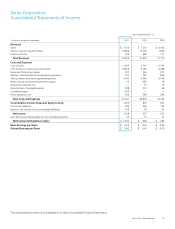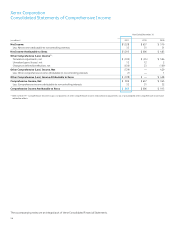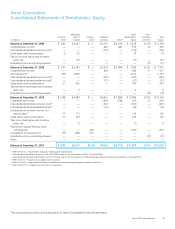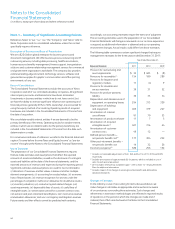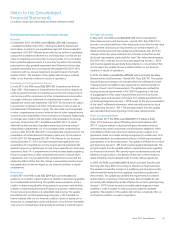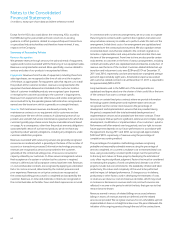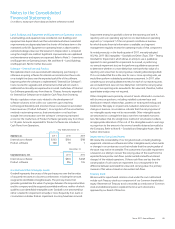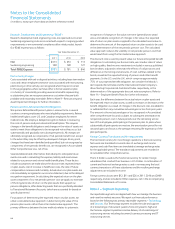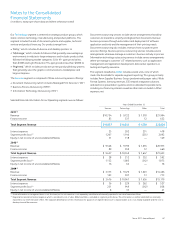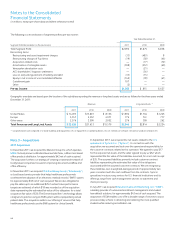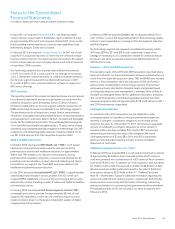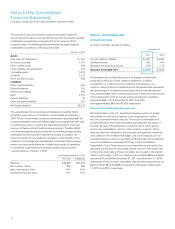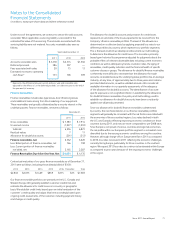Xerox 2011 Annual Report Download - page 64
Download and view the complete annual report
Please find page 64 of the 2011 Xerox annual report below. You can navigate through the pages in the report by either clicking on the pages listed below, or by using the keyword search tool below to find specific information within the annual report.62
Except for the ASUs discussed above, the remaining ASUs issued by
the FASB during the year entail technical corrections to existing
guidance or affect guidance related to unique/infrequent transactions
or specialized industries/entities and therefore have minimal, if any,
impact on the Company.
Summary of Accounting Policies
RevenueRecognition
We generate revenue through services, the sale and rental of equipment,
supplies and income associated with the financing of our equipment sales.
Revenue is recognized when earned. More specifically, revenue related to
services and sales of our products is recognized as follows:
Equipment: Revenues from the sale of equipment, including those from
sales-type leases, are recognized at the time of sale or at the inception
of the lease, as appropriate. For equipment sales that require us to install
the product at the customer location, revenue is recognized when the
equipment has been delivered and installed at the customer location.
Sales of customer-installable products are recognized upon shipment
or receipt by the customer according to the customer’s shipping terms.
Revenues from equipment under other leases and similar arrangements
are accounted for by the operating lease method and are recognized as
earned over the lease term, which is generally on a straight-line basis.
Services: Technical service revenues are derived primarily from
maintenance contracts on our equipment sold to customers and are
recognized over the term of the contracts. A substantial portion of our
products are sold with full service maintenance agreements for which the
customer typically pays a base service fee plus a variable amount based
on usage. As a consequence, other than the product warranty obligations
associated with certain of our low-end products, we do not have any
significant product warranty obligations, including any obligations under
customer satisfaction programs.
Revenues associated with outsourcing services are generally recognized
as services are rendered, which is generally on the basis of the number of
accounts or transactions processed. Information technology processing
revenues are recognized as services are provided to the customer,
generally at the contractual selling prices of resources consumed or
capacity utilized by our customers. In those service arrangements where
final acceptance of a system or solution by the customer is required,
revenue is deferred until all acceptance criteria have been met. Revenues
on cost-reimbursable contracts are recognized by applying an estimated
factor to costs as incurred, determined by the contract provisions and
prior experience. Revenues on unit-price contracts are recognized at
the contractual selling prices as work is completed and accepted by the
customer. Revenues on time-and-materials contracts are recognized at
the contractual rates as the labor hours and direct expenses are incurred.
In connection with our services arrangements, we incur costs to originate
these long-term contracts and to perform the migration, transition and
setup activities necessary to enable us to perform under the terms of the
arrangement. Initial direct costs of an arrangement are capitalized and
amortized over the contractual service period. We also capitalize certain
incremental direct costs that are related to the contract origination or
transition, implementation and setup activities and amortize them over
the term of the arrangement. From time to time, we also provide certain
inducements to customers in the form of various arrangements, including
contractual credits, which are capitalized and amortized as a reduction of
revenue over the term of the contract. Customer-related deferred set-up/
transition and inducement costs were $294 and $134 at December 31,
2011 and 2010, respectively, and are amortized over a weighted average
period of approximately eight years. Amortization expense associated
with customer-related contract costs at December 31, 2011 is expected to
be approximately $80 in 2012.
Long-lived assets used in the fulfillment of the arrangements are
capitalized and depreciated over the shorter of their useful life or the term
of the contract if an asset is contract-specific.
Revenues on certain fixed-price contracts where we provide information
technology system development and implementation services are
recognized over the contract term based on the percentage of
development and implementation services that are provided during
the period, compared with the total estimated development and
implementation services to be provided over the entire contract. These
services require that we perform significant, extensive and complex design,
development, modification or implementation of our customers’ systems.
Performance will often extend over long periods, and our right to receive
future payment depends on our future performance in accordance with
the agreement. During 2011 and 2010, we recognized approximately
$320 and $270, respectively, of revenue using the percentage-of-
completion accounting method.
The percentage-of-completion methodology involves recognizing
probable and reasonably estimable revenue using the percentage of
services completed, on a current cumulative cost to estimated total cost
basis, using a reasonably consistent profit margin over the period. Due
to the long-term nature of these projects, developing the estimates of
costs often requires significant judgment. Factors that must be considered
in estimating the progress of work completed and ultimate cost of the
projects include, but are not limited to, the availability of labor and labor
productivity, the nature and complexity of the work to be performed
and the impact of delayed performance. If changes occur in delivery,
productivity or other factors used in developing the estimates of costs
or revenues, we revise our cost and revenue estimates, which may result
in increases or decreases in revenues and costs, and such revisions are
reflected in income in the period in which the facts that give rise to that
revision become known.
Revenues earned in excess of related billings are accrued, whereas
billings in excess of revenues earned are deferred until the related
services are provided. We recognize revenues for non-refundable, upfront
implementation fees on a straight-line basis over the period between the
initiation of the ongoing services through the end of the contract term.
Notes to the Consolidated
Financial Statements
(in millions, except per-share data and where otherwise noted)


